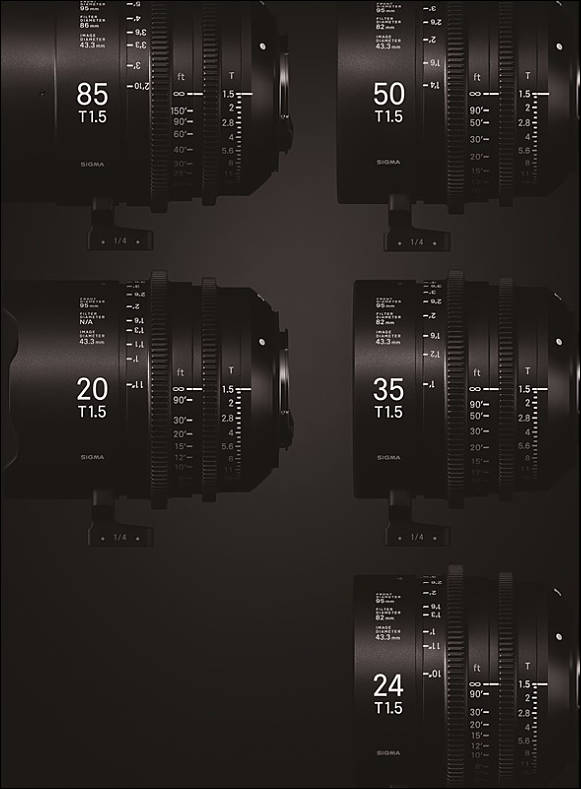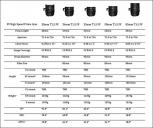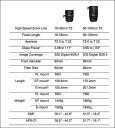
It allows to keep PV going, with more focus towards AI, but keeping be one of the few truly independent places.
-

http://www.sigma-global.com/en/cine-lenses/products/
Seems Sigma has done the homework.
The high speed zooms look very interesting. I am curious for the pricingPR
The SIGMA CORPORATION is pleased to announce that it will enter into the cinema lens market with the release of its SIGMA CINE LENSES, designed specifically for cinematography. In the world of digital film production, there is an increasing demand for higher resolution, and SIGMA’s new lineup of high-performance lenses is compatible with the latest, high-resolution digital cinema cameras. SIGMA has developed its own production system by establishing the required technology for mass production of high-performance lenses for ultra-mega-pixel shooting. The company feels this valuable new lens line could create a fundamental change in digital film production, and provide a new solution for cinematographers.
- Unbeatable value – the highest optical performance in its class and outstanding compact design
- Wide range of lenses for professional use
- Optimized for the latest digital moviemaking technology
For the first phase, SIGMA will release two zoom lenses in Japan and the USA for EF and E mount camera systems. Furthermore, another zoom lens and five prime lenses will be released to the market in sequence from 2017 onward. SIGMA plans to develop additional zoom and prime lenses as well as add support for PL mount camera systems. The latest release information will be sequentially updated on its official website.
High Speed Zoom Line
High Speed Zoom Line offers the constant aperture of T2 throughout the zoom range, and the optical performance is ready for high-resolution shooting such as 6K - 8K. Furthermore, while offering the highest image quality in its class, the High Speed Zoom Line has a compact construction and offers amazing value.
FF Zoom Line
FF Zoom Line is compatible with a full-frame image circle, and the optical performance is ready for high-resolution shooting such as 6K - 8K. It provides a rare option for cinematographers since very few lenses can cater to the requirements of the latest digital cinema cameras' image sensor, which is larger than Super 35, and expand the range of compatible cameras. This is the cinema zoom lens offering the highest image quality and compact design. This lens is not available in PL mount.
FF High Speed Prime Line
The lineup ranges from 20mm to 85mm, and all five lenses are T1.5. They are compatible with full-frame sensors and, while being more compact, can offer superior resolution than other high-end prime sets do. With the five prime lenses from FF High Speed Prime Line, there is no need to change the lighting to shoot a variety of cuts. These lenses bring a consistent level of light to the production and offer greater consistency with regards to the film’s look and color/contrast before it enters post-production.
Each CINE lens model is weatherproof and has luminous paint markings to aid in changing and operating the lens in the dark. It touts a long focus rotation of 180 degrees and is guided by cams for smooth operation and accuracy. The CINE lens design features standardized essentials such as an 82mm front for ND filters* and a 95mm front diameter for matte box use and standard gear positions for accessories like follow focus. They also include a manual linear iris control and electronic mounts that provide vital camera metadata. Each lens is manufactured and inspected in the Sigma factory located in Aizu, Japan.
Availability/Pricing
Availability: toward the end of 2016 (in Japan and USA in the first phase)
Pricing: TBD
 img1359.jpg581 x 789 - 44K
img1359.jpg581 x 789 - 44K
 img1360.jpg702 x 586 - 75K
img1360.jpg702 x 586 - 75K
 img1361.jpg427 x 571 - 43K
img1361.jpg427 x 571 - 43K
 img1362.jpg537 x 598 - 61K
img1362.jpg537 x 598 - 61K -
I've had a hands on session at a private event last month with Sigma. The lenses are definitely very nice! Much nicer build quality than the XEENs and even the CP.2 and CN-E primes. There were some uneven friction with the gear ring rotation, but I suspect it's because they were prototypes.
The zooms did well in regards to breathing and parfocal, if I recall correctly. I'm so glad that the T2.0 zooms and the primes are all coming with PL mounts (interchangeable to FE and EF, too).
-
I doubt they'll be parfocal or precise in distance marks with all EF mounts, since those are not very precise and not shimmable like the PL mount. No problem on a Red, though, since you can shift the sensor block in all the higher models.
-
http://www.newsshooter.com/2016/09/09/ibc-2016-hands-on-with-the-new-sigma-cine-lenses/
"He was able to confirm that all the lenses have the exactly the same optical design as their stills counterparts. The big difference is in the usability for filmmaking – they have all new metal housings with 180 degree focus rotation, 95mm lens fronts and cine gearings."
-
Kazuto told that probably all the cinema lenses will be under $5000.
Finally, Sigma settled on 450% margins. Thanks god!
-
Prices really deliver
New York, NY – October 20, 2016 – Sigma Corporation of America, a leading DSLR lens, camera, flash and accessory manufacturer, announced today that the Cine High Speed Zoom 18-35mm T2 and 50-100mm T2 lenses will begin shipping on December 9, 2016 for a retail price of $3999.00 USD. Born from the new Sigma Cine family of products, the High Speed Zoom lenses leverage the outstanding optical design of the company’s world-renowned Global Vision still photography lenses. Combined with the 100% new mechanical lens body design, the Cine lenses meet needs of advanced 6k and 8k cinema production with the core optical quality DNA that has defined the Sigma benchmark of imaging excellence.
See the Sigma Cine Family of Products at PDN/PPE 2016 Expo
Demonstrated for the first time to the public in the United States, attendees to the 2016 PDN PhotoPlus International Conference + Expo (PPE), held at the Javits Convention Center in New York City from October 20-22, 2016, can see first-hand the new Sigma Cine family of lenses:
Cine High Speed Zoom Line - 18-35mm T2 and 50-100mm T2
The high speed zoom line, which is compatible with the Super35 image size standard, offers the constant aperture of T2 throughout the zoom range with superior optical performance that is capable of high-resolution 6K-8K shooting. Delivering the highest image quality in its class, the High Speed Zoom is ergonomically compact and designed for E, EF and PL camera system mounts.
Cine FF Zoom Line - 24-35mm T2.2 FF
Compatible with a full-frame image sensor, the FF Zoom’s outstanding optical performance also supports 6K-8K shooting. Because so few lenses cater to the requirements of the latest digital cinema cameras’ image sensors, this line provides a rare option for cinematographers. The FF Zoom is designed for E and EF camera system mounts.
Cine FF High Speed Prime Line - 20mm T1.5 FF, 24mm T1.5 FF, 35mm T1.5 FF, 50mm T1.5 FF and 85mm T1.5 FF
The Cine High Speed Prime lineup features lenses ranging from 20mm to 85mm, with all five touting an aperture of T1.5. Highly compact and compatible with full-frame sensors, these lenses offer superior resolution. They bring a consistent level of light to the production, offering greater consistency to any film’s color, contrast and overall look before it enters post-production. The FF High Speed Prime line is designed for E, EF and PL camera system mounts.
-
Ouch!! Out of my reach by far :-/ :-(
-
This lenses and prices are aimed at corporations and media outlets that are bigger and bigger, plus on large rental houses. Margins of such lenses are huge (as only metal parts are unique, all optics are mass produced and cheap).
-
@IronFilm ouch is right. Still using my first generation Panasonic 20mm which has no giant housing or gears but takes incredible, jaw dropping video.
-
It's a small market, so yeah the price reflects that.
Having said that, in terms of optical quality, speed, and having mechanics of a proper cine lens, these are kind of in a class of their own for the price. The Xeen's are not even close optically, and everything else is more expensive.
There are two issues though, for a pricey cine lens: They are most likely not truly parfocal, and the big one breathes like crazy. It remains to be seen if those traits are addressed at all in the cine versions. Doubtful since you'd imagine they would trumpet that very loudly in the PR.
-
I've been around these lenses and they are parfocal, actually, and surprisingly, even for the 50-100mm. The breathing is a bit more pronounced with the 50-100mm, but far less than I expected. The 18-35mm has very little breathing.
By the way, I was surprised when I used the ARRI Ultra primes how much they breathe. Really unacceptable for their price.
$4,000 for these the 18-35mm T2 and 50-100mm T2 is actually hell of a deal, considering how much typical cinema zoom with proper gearing/housing and parfocal performance usually cost, let alone with that T2 speed!
-
$4,000 for these the 18-35mm T2 and 50-100mm T2 is actually hell of a deal, considering how much typical cinema zoom with proper gearing/housing and parfocal performance usually cost, let alone with that T2 speed!
They cost so much for a reason - as price include all development costs, extremely inefficient production costs, and all owners profit (and this guys are very greedy), very inefficient running costs (where most of tech people do nothing for most of the time) and all this is spread on tiny amount of sold lenses.
With Sigma we have all the means of production and development costs and all optical part already covered, it is actually almost zero cost for such firm.
-
No, there's definitely cost to develop these cinema lenses. Unlike the cheap Rokinon Cine DS that were straight rehousing of the Rokinon still photos, these Sigma Cine lenses are completely built from the ground up save the optics. New gearing, better material, higher build tolerance and precision, hard stops, expanded focus, aperture, and zoom range, and not the mention parfocal performance are NOT zero costs.
How do I know all of this? Because 2 months before this was all announced I was invited by Duclos Lenses here in Los Angeles to attend a private presentation along with other cinematographers by the Sigma USA President and Sigma Global President to showcase these lenses.
We tested them out not only with multiple cameras, but also on Duclos Lenses's test machines.
Maybe I'm just used to working with ARRI, Cooke, Angenieux, and Fujinon lenses, so my perspective on "affordable" lenses is much different than the majority of people in this forum, but I do think that these Sigma lenses are priced attractively.
Now just have to see how they perform vs cine primes at this price range from Zeiss (hate the CP.2s), Canon (CN-E is nice and warm), and Schneider (really like the look and quality of the Xenons, except for the purple fringing at wide open).
-
Unlike the cheap Rokinon Cine DS that were straight rehousing of the Rokinon still photos, these Sigma Cine lenses are completely built from the ground up save the optics. New gearing, better material, higher build tolerance and precision, hard stops, expanded focus, aperture, and zoom range, and not the mention parfocal performance are NOT zero costs.
But all this is done by same engineers, and their salary really do not change if they work on Cine lenses or cheap kit zooms. It is already included in regular expenses.
Almost all means of production was already present before Cine lenses production. Of course they can get few new stuff, but I am sure that to load it fully it is utilized for other lenses also.
I do not know precisely about Sigma, but I know about some other premium product in same price ranges and know about huge margins (it does not mean that profit is too big, as sales are not) and how owners are super angry if someone ask to lower margins.
How do I know all of this? Because 2 months before this was all announced I was invited by Duclos Lenses here in Los Angeles to attend a private presentation along with other cinematographers by the Sigma USA President and Sigma Global President to showcase these lenses.
Can you write in more details about this here?
Maybe I'm just used to working with ARRI, Cooke, Angenieux, and Fujinon lenses, so my perspective on "affordable" lenses is much different than the majority of people in this forum, but I do think that these Sigma lenses are priced attractively.
I know quite good amount of people on PV who also used top lenses. They just are not too vocal.
I think all industry made wrong choice and went to the past instead of looking to the future with cine lenses construction and design.
-
The thing about cinema lenses is that they are typically used more for productions (even small ones like film school projects) with a DP/camera op and 1st AC (Assistant Camera) pulling focus. I predominantly work in the industry here in Los Angeles as a 1st AC, and at times as DP or camera op.
There are a lot of tried and true things about lens design and manufacturing that we all look for, from precision needed to have accurate distance witness marks (I pull focus from actually looking at distance between camera and subject just as much as I look at a field monitor), controlled breathing, parfocal, and build quality to withstand the 12-hours/day x multiple days/weeks on a shoot.
So there is a higher degree of standard, just like a high-performing Porsche, when it comes to building proper cinema lens for studio-style productions.
Technology-wise, there are quite a few things like the ARRI LDS and Cooke /i open-source electronic lens metadata that are built into a lot of cinema lenses from ARRI, Cooke, Angenieux, Fujinon, Leica, etc. Panavision's new Primo 70 lenses actually have internal gear motor that allows the new Panavision DXL to internally drive the FIZ (Focus Iris Zoom).
Now if you want to talk about future things in lenses, the question of future mounts that can accommodate full-frame 35mm (VistaVision) sensors is something that the industry is talking about. The mount has to be big enough, but robust enough like PL Mount. This is a fascinating read and I definitely agree on Sony's FZ mount on the F5/F55/F65. It's like a beefed up E-mount that works like PL mount, but you can adapt practically any non-mirrorless mount:
-
Great to hear about the breathing and that they are parfocal after all.
-
GL Optics version
-
Sigma Japan told that 18-35mm T2.0 and Sigma 50-100mm T2.0 will start shipping in December 2016.
All other lenses will be ready only late in 2017.
-
Sigma’s Shinji Yamaki told that the lenses are “near parfocal”, rather than parfocal.
:-)
-
50-100mm test
-
18-35 T2 Cine Test
-
50-100mm T2 test
Howdy, Stranger!
It looks like you're new here. If you want to get involved, click one of these buttons!
Categories
- Topics List23,992
- Blog5,725
- General and News1,354
- Hacks and Patches1,153
- ↳ Top Settings33
- ↳ Beginners256
- ↳ Archives402
- ↳ Hacks News and Development56
- Cameras2,367
- ↳ Panasonic995
- ↳ Canon118
- ↳ Sony156
- ↳ Nikon96
- ↳ Pentax and Samsung70
- ↳ Olympus and Fujifilm101
- ↳ Compacts and Camcorders300
- ↳ Smartphones for video97
- ↳ Pro Video Cameras191
- ↳ BlackMagic and other raw cameras116
- Skill1,960
- ↳ Business and distribution66
- ↳ Preparation, scripts and legal38
- ↳ Art149
- ↳ Import, Convert, Exporting291
- ↳ Editors191
- ↳ Effects and stunts115
- ↳ Color grading197
- ↳ Sound and Music280
- ↳ Lighting96
- ↳ Software and storage tips266
- Gear5,420
- ↳ Filters, Adapters, Matte boxes344
- ↳ Lenses1,582
- ↳ Follow focus and gears93
- ↳ Sound499
- ↳ Lighting gear314
- ↳ Camera movement230
- ↳ Gimbals and copters302
- ↳ Rigs and related stuff273
- ↳ Power solutions83
- ↳ Monitors and viewfinders340
- ↳ Tripods and fluid heads139
- ↳ Storage286
- ↳ Computers and studio gear560
- ↳ VR and 3D248
- Showcase1,859
- Marketplace2,834
- Offtopic1,320
Tags in Topic
- lenses 152
- sigma 71
- cinematography 22







